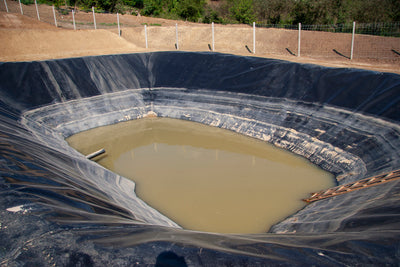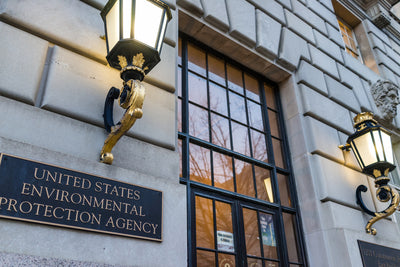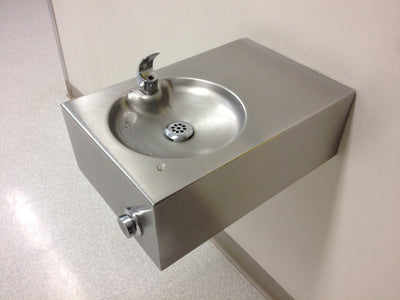Water Quality InformationWritten By Actual Experts
RSSDrinking Water Supplies Risk Contamination from Toxic Wastewater Ponds

Latest Revisions to the Lead and Copper Rule

Analies Dyjak, M.A. | Head of Policy and Perspectives
Updated 12/8/2023 to include new EPA proposals
Lead Pipes Are Still Problematic in 2023
In April 2023, the EPA released a report with a comprehensive assessment of service line infrastructure, and revealed that an estimated total of 9.2 million lead pipes are servicing homes across the country. Many homes containing lead plumbing were built before 1986, when the use of lead was banned in pipes, solder and plumbing. Flint, Michigan dominated headlines in 2015 when 99,000 people were exposed to unsafe levels of lead, including thousands of children. However, Flint was not and is not the only city with unsafe lead levels. There are dozens of large cities that have lead levels above what health officials claim to be safe, including Chicago, Boston, New York City, and Los Angeles.
No Safe Level Of Lead For Children
The current federal Action Level for lead in drinking water is 15 parts per billion. Lead is unique from other drinking water contaminants because it follows the 90th Percentile Rule, which has been criticized by various reputable environmental non-profits. The Centers for Disease Control has acknowledged that 15 parts per billion is not a health standard, but rather a feasible level of enforcement - meaning anything less than 15 parts per billion is too stringent for municipal compliance. The American Academy of Pediatrics has stated that there is no safe level of lead for children. Any level of exposure has the potential to cause irreversible developmental damages, including; lowered IQ’s, behavioral difficulties, and other learning problems. EPA has even acknowledged that children should not be exposed to any level of lead.
2021 Updates
EPA made a handful of small modifications to the original 1991 Lead and Copper Rule. One of the major updates to the rule is increasing EPA’s “inventory” of Lead Service Lines throughout the country. Once LSL’s and pipes have been identified, EPA will require communities to “find and fix'' homes that exceed 15 parts per billion. The system must provide documentation to the state if they’re unable to fix or mitigate the lead levels. Under the rule revisions, systems serving greater than 50,000 people will be required to make the LSL inventory available online. Also, municipal systems will be required to provide annual notices to homeowners with LSL’s. Replacing LSL’s are particularly tricky to manage because they’re co-owned by the city and homeowner. Some cities have programs to coordinate replacing the public and private side of the line at the same time.
EPA’s New “Trigger Level” For Lead
Part of EPA’s revisions to the Lead and Copper Rule include a new “trigger level.” According to the regulatory revisions, systems that have a 90th percentile higher than 10 parts per billion will be required to work with their state to determine annual lead line replacement goals. This “trigger level” is not a new Action Level, and does not initiate a violation if a water system has higher than 10 ppb lead. EPA also pointed out in the proposed regulation that the trigger level is also not a health standard. As previously stated, any concentration of lead can be harmful to children.
2023 Proposed Updates to the Lead and Copper Rule
On November 30, 2023, the U.S. Environmental Protection Agency (EPA) announced new proposed Lead and Copper Rule Improvements.
Key provisions in the proposal include:
- 100% Lead Pipe Replacement within 10 years.
- Locating Legacy Lead Pipes. Water systems are currently required to provide an initial inventory of their lead service lines by October 16, 2024. Under the proposal, all water systems would be required to regularly update their inventories, create a publicly available service line replacement plan, and identify the materials of all service lines of unknown material.
- Improving Tap Sampling. The proposal would make key changes to protocols that water systems must use for tap sampling informed by best practices.
- Lowering the Lead Action Level. EPA is proposing to lower the lead action level from 15 µg/L to 10 µg/L. When a water system’s lead sampling exceeds the action level, the system would be required to inform the public and take action to reduce lead exposure while concurrently working to replace all lead pipes. For example, the system would install or adjust corrosion control treatment to reduce lead that leaches into drinking water.
- Strengthening Protections to Reduce Exposure. Water systems with multiple lead action level exceedances would be required to conduct additional outreach to consumers and make filters certified to reduce lead available to all consumers.
EPA anticipates finalizing the Lead and Copper Rule Improvements prior to October 16, 2024.
Will The New Updates Better Protect Public Health?
In the short term, no. There is no real "quick fix" for lead contamination. Replacing lead pipes and Lead Service Lines takes time, and can actually cause an increase in lead levels during and after construction. These changes are a step in the right direction, but implementation takes time.
To protect yourselves and your families in the meantime, here are some recommendations on how to reduce your lead exposure:
-
Allow your faucet to run for 2 minutes prior to drinking tap water.
-
See if your city or town has a free lead testing program. Washington D.C., New York City, and several other cities have a free lead testing program. If you live in an area that doesn’t have free lead testing, you can pay to send your sample to get laboratory tested.
-
Purchase a filter that is optimized and certified to remove lead from drinking water.
How To Tell If Your Home Has Lead Plumbing
What Are 'Forever Chemicals' or PFAS?
Everything You Need To Know About TDS/ppm Meters
Lead and Copper Rule: What You Need to Know

Analies Dyjak | Policy Nerd
Updated 12/8/23 to include EPA's new Proposed Lead and Copper Rule Improvements
Since 1991, the Lead and Copper Rule (LCR) has aimed to regulate public drinking water systems by specifically targeting lead and copper contamination. It was created by Congress to protect human health, but there are several exemptions and loopholes that compromise its overall mission. Additionally, it’s still considered to be one of the most complicated environmental statues. This article discusses the major insufficiencies of the Lead and Copper Rule, as well as recommendations to protect your family from drinking water contamination.
How Does Lead Enter Tap Water?
Lead enters tap water through old lead service pipes and plumbing including fixtures and fittings that contain lead. Water that leaves a treatment plant may be in compliance with current EPA standards, but can become contaminated once it enters older infrastructure including an estimated 9.2 million lead service lines that serve water to properties in communities across the United States. Houses built before 1986 were most likely built with lead pipes and lead plumbing.
What are the Health Effects of Lead Contamination in Drinking Water?
The EPA, the Centers for Disease Control and Prevention (CDC), and the American Academy of Pediatrics all agree that there is no known safe level of lead in a child's blood. Even though an action level of 15 parts per billion is currently in place, that is not considered a safe level for children. The regulatory and medical organizations all agree that the only safe level of lead is zero. The scientific community and most regulatory agencies have acknowledged this, but municipalities still follow an extremely high threshold of lead in drinking water. A dose of lead that would have little to no impact on adults can have a significant and lifelong impact on an infant or child. They are the most sensitive population in the case of lead because it’s a neurotoxin and healthy brain development between the years of 0-5 is crucial. Learning disabilities, shorter stature, hearing impairment, and impairment of the formation and function of blood cells are just some of the health effects in children. Pregnant Women are also sensitive to lead contamination in drinking water. Lead accumulates in bones where it’s stored with calcium. Lead is released from bones in the form of maternal calcium which is used to help develop the fetus. Lead can also enter the placenta and have serious developmental effects on the fetus.
What is the Lead and Copper Rule?
The EPA's Lead and Copper Rule (40 CFR Part 141 Subpart 1) is part of the National Primary Drinking Water Regulations under the Safe Drinking Water Act. The rule governs 68,000 public water systems across the United States, and has created provisions to help reduce lead and copper throughout community water systems. While the goals of this statute are in good faith, there are several loopholes, exemptions, and regulatory flaws that don’t necessarily prioritize human health. The most obvious and deceptive flaw is the 90th percentile rule. Only the 90th percentile of users must meet the EPA threshold of 15 parts per billion ( 0.015mg/L ) for lead and 1.3mg/L 1.3 parts per billion (1.3mg/L) for copper. This means that 10% of users can be in exceedance of the threshold and still be in compliance with the law.
What are the Sampling Requirements Under the Lead and Copper Rule?
There are many other components of the EPA's Lead and Copper Rule that leave users confused about what’s in their water. The most profoundly disappointing part of the Lead and Copper Rule is the municipal sampling requirements. The sampling protocol requires municipalities to collect a set number of residential samples, rather than a percentage of households within a community. For example, if a public water system services 100,000 people, they are only required to collect 100 samples, rather than a percentage of the total population. Municipalities that have 10,000-100,000 residents are required to collect 60 samples and municipalities with 3,301-10,000 residents are only required to collect 40 samples. Houses built before 1986, (when the use of household lead pipes became illegal), were most likely built with lead infrastructure. The bottom line is, very few households are made aware of lead contamination. In addition, a public water system servicing less than 50,000 people can be eligible for “reduced monitoring” which decreases the number of samples they are required to collect. Reduced monitoring means that municipalities are only required to collect residential tap water samples once every 3 years. Systems that service 3,300 or fewer people can receive a waiver from the state allowing them to test for lead and copper once every 9 years. 9 years is an unreasonably long time between tests for drinking water quality. Lead concentrations can change overnight, especially if source water or corrosion control measures change.
Who Regulates Lead In Drinking Water?
Municipalities must disclose information about lead and copper in their drinking water to State officials and residents in the form of annual Consumer Confidence Reports. In 2007, revisions were made to the statute that sought to improve transparency between local, state, and federal agencies. The 2007 revisions to the EPA's Lead and Copper Rule require municipalities to notify either state or federal agencies if they have plans to change their treatment methods/source water, or anything else that might in any way increase the corrosion potential of lead. The lead agency is then required to approve these changes before they are implemented. Through this revision, municipal water providers must also notify residents about changes that may affect lead levels. The 2015 lead crisis in Flint, Michigan often comes to mind in this context. It’s important to note that the crisis in Flint occurred after this revision. Protocols were in place, yet regulatory agencies still failed to communicate.
How Are Water Samples Collected and Tested For Lead?
The Lead and Copper Rule developed a sampling protocol for both pre-selected and voluntary households. Municipalities initially pre-select “Tier 1” sites, which are older homes that most likely contain lead lines. However, homeowners can deny testing or fail to submit a sample if they choose to do so. If an inadequate number of Tier 1, Tier 2, or Tier 3 samples are collected, the municipality will then draw samples from “representative sites.” At these sites, local officials are in complete control of how samples are collected. The Lead and Copper Rule requires a 1 liter “first draw” sample, which is water that has been stagnant in plumbing for at least six hours. Samples should be taken from a tap that’s typically used for consumption of drinking water.
Invalidating Lead-Containing Water Samples
A state agency has the authority to invalidate sampling if; the laboratory establishes improper sample analysis causing erroneous results, the state determines that the sample was taken from a site that did not meet the site selection criteria, the sample was damaged in transit or if “there is substantial reason to believe that the sample was subject to tampering.” Essentially, state laboratories can omit samples for a whole breadth of reasons. Several municipalities have been caught cheating the system by discarding samples with high lead levels. Some municipalities instruct residents to “pre-flush” and allow their taps to run for five minutes the night before sampling. This helps to clear stagnant water which completely defeats the purpose because “pre-flushing” has been cited as an effective way to reduce lead levels in drinking water. Other municipalities have told residents to wait until their water “runs cold” before testing, which accomplishes the same thing as pre-flushing.
Are Municipalities Required to Replace Lead Service Lines?
If 10% of water samples exceed the 15 part per billion action level after corrosion control and source water treatment requirements have been met, a municipality must replace 7% of lead service lines per year. Line replacements stop whenever new samples meet the lead action level for two consecutive monitoring periods. Monitoring periods can be anywhere from 6 months, 1 year, 6 years, or even up to 9 years is smaller communities. Once samples exceeding the action level are detected, the system has 12 months after the end of the monitoring period, to submit documents to the state that lay out an action plan.
Current Efforts to Update the Lead and Copper Rule
On November 30, 2023, the U.S. Environmental Protection Agency (EPA) announced new proposed Lead and Copper Rule Improvements.
Key provisions in the proposal include:
- 100% Lead Pipe Replacement within 10 years.
- Locating Legacy Lead Pipes. Water systems are currently required to provide an initial inventory of their lead service lines by October 16, 2024. Under the proposal, all water systems would be required to regularly update their inventories, create a publicly available service line replacement plan, and identify the materials of all service lines of unknown material.
- Improving Tap Sampling. The proposal would make key changes to protocols that water systems must use for tap sampling informed by best practices.
- Lowering the Lead Action Level. EPA is proposing to lower the lead action level from 15 µg/L to 10 µg/L. When a water system’s lead sampling exceeds the action level, the system would be required to inform the public and take action to reduce lead exposure while concurrently working to replace all lead pipes. For example, the system would install or adjust corrosion control treatment to reduce lead that leaches into drinking water.
- Strengthening Protections to Reduce Exposure. Water systems with multiple lead action level exceedances would be required to conduct additional outreach to consumers and make filters certified to reduce lead available to all consumers.
EPA anticipates finalizing the Lead and Copper Rule Improvements prior to October 16, 2024.
Our Take
We need ways to incentivize voluntary lead testing for homeowners as well as at the municipal level. Right now many municipalities may be unaware of lead problems within a community, or overlook these concerns due to the cost of mitigation, because some municipalities legitimately don’t have the funding to properly address longstanding infrastructure issues. In a regulatory sense, the EPA's Lead and Copper Rule has been a convoluted mess. There are so many exemptions and loopholes, and the regulated sampling techniques offer little to no accuracy to what’s in people’s tap water. While the updates to the Lead and Copper Rule are a step in the right direction, actual improvements in water quality in many communities could still be decades away. Here are some recommendations on how to reduce lead exposure from our Water Nerds:
-
Allow your faucet to run for 2 minutes prior to drinking tap water.
-
See if your city or town has a free lead testing program. Washington D.C., New York City, and several other cities have a free lead testing program. If you live in an area that doesn’t have free lead testing, you can pay to send your sample to get laboratory tested.
-
Purchase a filter that is optimized and certified to remove lead from water.
Other Articles We Think You Might Enjoy:
Lead: What You Need To Know About This Toxic Heavy Metal With A Long HistoryThings To Know Before Replacing Your Home's Lead Service Pipes
How To Tell If Your Home Has Lead Plumbing or Lead Fixtures
Does New York City's Tap Water Have a Lead Problem?

Why Do So Many Schools Have Lead in the Drinking Water?

Eric Roy, Ph.D. | Scientific Founder
With schools in major cities across the country testing positive for lead contamination (e.g. New York City, Cleveland, Chicago, Portland, Newark, San Francisco), we get lots of questions about what’s happening. The goal of this article is to shed some light on why lead in school drinking water is such an important thing.
There is no level of lead that is known to be safe for children. Period.
Since lead contamination in tap water entered the spotlight in 2015, people have incorrectly presented EPA's regulatory limits as safe/not safe thresholds. While a simple safe/unsafe threshold would certainly make things more simple, the 15 ppb threshold was never intended to be a "safe level." It’s a limit that EPA established to evaluate city-wide corrosion control practices and it allows a city to have up to 10% of samples test ABOVE the 15 ppb threshold, and still be in compliance with the Lead and Copper Rule. For reference, the American Academy of Pediatrics is calling for regulatory changes that ensure that water never tests above 1 ppb in schools.
Most Schools Are Old & Old Plumbing Often Contains Lead
According to data assembled by the U.S. Department of Education, the average age of a Public School building in the United States is 44 years old, a time when lead-based plumbing was the norm. Even in newer schools, lead contamination can creep into water because lead wasn’t completely phased out of plumbing connections, fittings, and valves until 2014.
Weekends & Summers Allow Water To Sit Stagnant For Extended Periods Of Time In Schools
As many now realize, lead accumulates in water when it leaches from lead-containing pipes, valves, and plumbing connections. The longer water sits stagnant in pipes, the more lead it can accumulate. Unlike in homes, where water is used on a daily basis and never sits stagnant for more than a few hours each night, water in schools goes completely unused for long periods of time each weekend, vacation, and summer. These frequent long periods where water is not used are detrimental for two reasons:
- Lead has more time to accumulate as water sits stagnant in lead-containing pipes
- The lack of flushing prevents corrosion measures from rebuilding the protective layer that prevents lead from leaching out in the first place.
Most Schools Do Not Test Water Properly For Lead Contamination
It sounds crazy, but most schools don’t test for lead contamination in water. When asked by a reporter about testing the school’s water for lead, an elementary school superintendent went on record to say that "We do not test because it has never been brought up as a concern, nor is it a requirement to do so."
The reality is, even if schools choose to test for lead contamination, it’s much more complicated than testing in a residential home. In a residential home, EPA sampling protocols require that water be unused for 6 hours, in order to simulate the night and work day periods where water commonly sits stagnant in pipes. However, this protocol does not mimic how water is used in schools, because in addition to the 12 hours each school night the water goes unused, it sits stagnant for roughly 60 hours each weekend, and much longer periods over school vacations and summer.
How Can Schools Reduce Lead Contamination In Drinking Water?
Realistically, it’s probably cost-prohibitive for schools to replace all lead-containing plumbing or buy and maintain effective point of use drinking water filters that remove lead. When school administrators approach us for solutions, we always advise them to take immediate steps to identify lead containing plumbing, test their water for lead, and to implement regular pipe flushing protocols.
We encourage everyone to call their city's school department to better understand if and how lead is being tested for in schools. Because testing in schools is very complicated, we encourage people to ask for specifics of the testing program and actual results, not blanket assurances that everything is ok.
What Can I Do About Lead In Schools?
While replacements to lead service lines are taking place in many cities across the country, improvements to the water supply won’t happen overnight. Here are 4 things you can do in the meantime to help keep your school children safe from lead-contaminated water in the school buildings:
-
Check your Filters. If you are packing water for your child, please check to make sure you are using a filter that is certified for lead removal.
-
Get informed. Ask school administrators whether the drinking water in your child’s school has been tested for lead and ask to see the results. Information on lead in drinking water, testing methods, and steps you can take to minimize exposure is available from the Safe Drinking Water Hotline or on the EPA’s page: Basic Information about Lead in Drinking Water.
-
Be an Advocate. Encourage your school or district to install water dispensers or drinking fountains that use filters certified for lead removal.
-
Spread the word. Talk to your child’s pediatrician, school nurse, teacher, and your school’s parent-teacher association about lead in the drinking water in schools. Inform them that the American Academy of Pediatrics recommends 1 ppb to be a safe level of lead in drinking water.
Originally published on January 28, 2017. Updated August 17, 2022.
Related Articles:
Does New York City Tap Water Have A Lead Contamination Problem?
The Noah System: Lead-Free Drinking Water for America’s Schools
The American Jobs Plan to Allocate $111 Billion To Water Infrastructure Improvements




